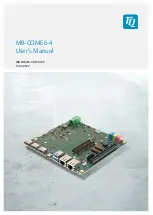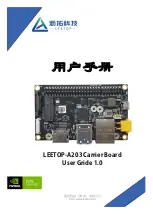
SoM-250ES_User_Manual_v1.40.doc
-5-
Rev 1.4 © 2014 EMAC, Inc.
2.2
Power Connectors
The SoM-250 provides two power connectors. J1 is an AMP/Tyco locking power connector (part# 640445-3),
three-pin type connector that mates with TE Connectivity part# 3-640600-3 power connector. Using this power
input provides for a more rugged/industrial locking connection. JK1 is a standard 5.5mm barrel jack with an inner
diameter of 2.1mm with a center V+ connection. This jack allows for easy connection to a wall mount power
supply (EMAC part number PER-PWR-00035). The SOM-250
’s power input uses a switching regulator and allows
a voltage input of +12V DC to +26V DC.
The pinout for the J1 power connector is as follows:
Pin
Signal
1
+Vin (+12Vdc to 26Vdc)
2
Chassis GND
3
System GND
2.3
Ethernet
The SoM-250 provides 10/100 Base-T full duplex Ethernet and uses a standard RJ-45 connector (JK2). It can be
connected straight to a hub, or another computer via a crossover Ethernet cable. The Ethernet MAC & PHY are
integrated into the SoM processor module. Activity and Link LEDs are integrated into the RJ45 connector.
2.4
CAN Port
The SoM-250 includes a CAN 2.0B port utilizing the TI SN65HVD232 CAN Transceiver chip. Note the CAN
controller must be supported by the SOM in order to have CAN functionality.
The pinout for the CN5 power connector is as follows:
Pin
Signal
1
CAN_H
2
CAN_L
3
GND
2.5
Serial Ports
The SoM-250 is equipped with four serial ports, one of which terminates to a male DB9 and the other three which
terminate to 10pin header connectors (see table 2, 3, & 4 below). Three 10-pin header to male DB9 connector
cables are provided, giving easy access to these ports. Baud Rate, stop bits, etc. are all programmable for each
port via software.
COM A is an RS232 compatible port with a full complement of handshaking lines allowing it to communicate with
modems and other devices requiring hardware flow control.
COM B is an RS232 port. This port offers no handshake lines.
COM C can be configured to RS232, RS422, and RS485 via 2 jumpers. To select RS232 set jumper JB6 to 232
(this is the default). For RS422 set jumper JB6 to 4xx and jumper JB5 to 485. To select RS485, set jumper JB6 to
4xx and jumper JB5 to 422.
When using COM C in the RS422/485 mode, a terminating resistor (~120 Ohm) is recommended on the two far
ends of the network.
COM D is an RS232 port. This port offers no handshake lines.























